Marketing for nonprofits can be daunting, from finding donors to asking for donations, the process has a lot of moving parts. Donors receive lots of requests, how will you cut through the noise and convince them to take action for your nonprofit?
You can implement several marketing methods, but in this guide, we will focus on how to use email marketing for nonprofits.
Why email marketing is essential for nonprofit organizations
Email marketing is transforming several nonprofits around the globe. Donors and volunteers prefer to get updates from nonprofits through emails.
Need some proof?
A study by Campaign Monitor showed that 42% of donors prefer hearing from nonprofits via email, and 21% of respondents claimed nonprofit emails inspire them to donate.
Email marketing is among the best marketing methods to drive more donations. It accounted for 28% of the revenue generated by nonprofits in 2017. To raise even more funds for your nonprofit, combine email with social media marketing.
Here’s what makes email marketing for nonprofits special:
- You own your list of donors, unlike Twitter or Instagram. If you lose your social media audience today, you will still drive donations through email marketing.
- You can gather followers on social media platforms. Nonprofits get an average of 110 Twitter and 199 Facebook followers per 1,000 email subscribers.
- It’s the best channel to provide accountability, clarify misunderstandings, and build trust. Give your subscribers donation reports and show them how you allocate funds. Donors will appreciate seeing what their resources are doing to help your cause.
- It has a high potential to grow donor count. You can create unlimited lead magnets or use subscription forms to capture new contacts. You can also run ads on Twitter or Facebook to bring prospects to your website and acquire their email addresses.
The best part?
You will communicate with donors in different parts of the world anytime you want.
Bottom line: Email marketing complements other marketing methods and adds synergy to your overall inbound efforts. Be sure to use a credible email service provider, segment your list like a pro, write great copies, and automate the process. Donors will reciprocate!
Nonprofit email marketing strategies to skyrocket donations
Starting a nonprofit can be intimidating, especially the email marketing efforts are going to be challenging since it is very important to get your nonprofit out in the public eye. In this section, we will focus on how you can supercharge your donor base, the email marketing tools to use, and give you some actionable tips to engage donors and volunteers.
Supercharge your donor base
The size of your mailing list directly affects your average donation amount. The M+R Benchmarks Report shows that nonprofits raise $45 for every 1,000 emails they send. You can generate a whopping $900, assuming you have 20,000 subscribers and 20 of them donate $45 each.
Use both online and offline methods to grow your mailing list.
Offline forms are great for capturing email addresses from visitors at your events. Remember to add a small box they can tick to acknowledge they want to receive your emails, as permission is an important part of email marketing.
However, online techniques are still more effective for gathering contacts en masse. Ask prospects to join your mailing list after they purchase tickets on your website or use lead magnets and subscription forms to capture their contacts online.
Let’s discuss subscription forms and lead magnets further.
A subscription form is a form placed in on your website for prospects to join a mailing list. Like lead magnets, prospects will enter their contact information to hear from you.
Below you can see a subscription form The Case Foundation placed in the footer of their website to gather email addresses and additional information from their potential donors.
 Subscription form by The Case Foundation
Subscription form by The Case Foundation
A lead magnet is a freebie like a case study, checklist, or a toolkit that you give your audience in exchange for their contact details. You will outdo other nonprofits if you master using lead magnets. Here’s the same nonprofit organization using a lead magnet to build their mailing list:
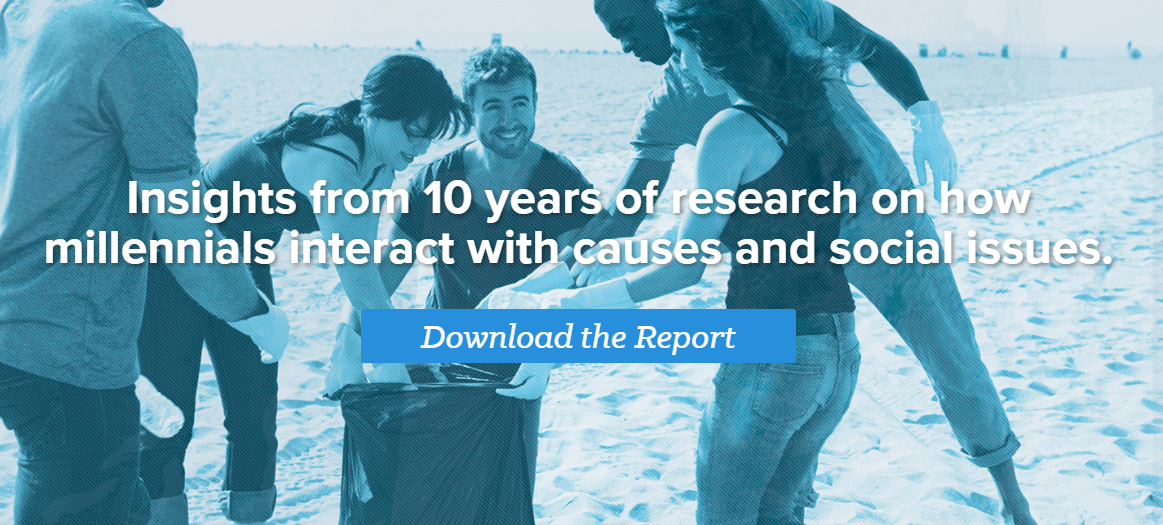 The Case Foundation offering a lead magnet
The Case Foundation offering a lead magnet
Remember, the lead magnet you offer should match the interests of your website visitors, and be related to the content of your landing pages. And what is even more important, you should deliver the freebie to their inbox instantly to build trust.
Pro tip: Prospects join mailing lists of nonprofits they’re truly interested in. So you can request that they whitelist your email address to boost deliverability.
Choose an email service provider
Even if your lead magnets and subscription forms are world-class, email marketing is only as good as your email service provider’s reputation and service. Your deliverability rate and sender score will deteriorate quickly if you use a bad service for email marketing.
You should choose a great email service provider that enables you to quickly and strategically send emails to your donors. Moreover, the chosen tool should be accessible and easy to use, with customizable email templates, a drag and drop editor, and automation capabilities.
Make readers crave more
Prospects have joined your list, now it’s time to make the first impression count. Welcome subscribers warmly and only send engaging and useful content.
We all love short email content. You can create teaser emails or emotional stories. They will click your links and make your content go viral if it highly resonates with them. Include social media sharing buttons in your emails.
Pro tip: Write an email copy as if donors and volunteers are next to you. Use catchy subject lines and don’t use click-bait because it will destroy the trust you invested time to build.
Costly nonprofit email marketing mistakes and how to avoid them
Getting your nonprofit email marketing up and running can take a lot of work, be time-consuming, and has lots of opportunities for mistakes. Let’s look at three common mistakes marketers make in nonprofit email marketing.
Overlooking mobile email rendering
Mobile email marketing is growing fast. The number of smartphone users is expected to hit 273 million in 2020.
Number of smartphone users in millions
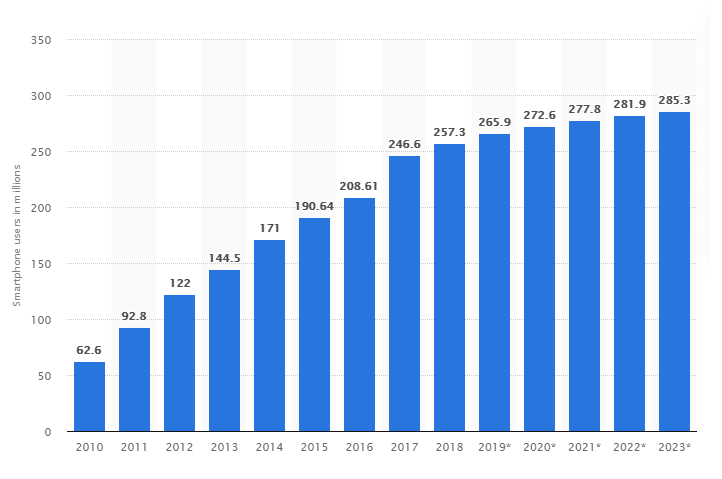 Source: Statista
Source: Statista
A recent Litmus report shows that in the first quarter of 2019, 42% of their clients opened incoming emails on mobile phones. Given this fact, you should consider the length of your subject lines, preheader text, email copy, and master how to position CTAs.
Avoid the following mistakes:
- Including more than 50 characters in your subject line. Mobile phones cut off part of subject lines if there are too many characters. Utilize the first 30 to 35 characters to hook subscribers to open your emails.
- Mixing font sizes. Recipients strain when reading email content with mixed fonts. Emails with small fonts are hard to read on phones, and your donors may delete or ignore any difficult to read emails. We recommend using a font size of 13 or 14 pixels.
- Incorporating large images. Add small images to cater to subscribers with slow internet connections. Code and optimize images for mobile phones or hire an expert to do it.
- Writing long email copies. Concise text displays well on mobile devices. Use short sentences, bullet points for scanners, and stress key points with bold.
Position your CTA after three to four lines to capture the attention of scanners.
Improve your preheader text to entice donors to open your email. Test and get the right preheader text length that works best on several mobile devices.
Ignoring email service providers
Your mailing lists will explode if your subscription forms and lead magnets are catchy. Like businesses, nonprofits need an efficient email service provider with awesome features like customizable templates. A great email service provider sends bulk messages fast with high deliverability. The best option is to segment your list, create targeted content, and use SendPulse.
Splurging on mailing lists
Purchasing a mailing list is not only costly but illegal. Chances are, you will buy a list from the seller ranking top on search engines and compete for the attention of the donors. You won’t be able to project the donation amounts that you will generate from a purchased list because it is unlikely that recipients engage with your campaigns.
Instead, acquire donors through the online and offline methods we discussed earlier. Lead magnets and subscription forms deliver great results in the long-term.
Nonprofit email marketing best practices
Email marketing best practices aid nonprofits to stay on top of their marketing game. In this section, we will look at the best frequency for sending nonprofit emails and the importance of personalization and segmentation. We will also look at why you need to avoid focusing only on donations and the importance of scrubbing your mailing list regularly.
Email sending frequency for nonprofits
How often nonprofits should send emails is still a hotly debated topic. Experts recommend doing testing to find the right number of emails that work for your company. You can also run surveys to understand more about how often donors want to receive emails from your organization.
Remember: What works for well-known nonprofits may not work for you. Study the sending patterns of successful nonprofits, compare and contrast them with yours.
Personalize and segment your mailing list
Nonprofits use personalization and segmentation to break through the noise and drive more donations. An Accenture study found that 44% of donors are willing to contribute 10% more for a personalized experience.
To gather valuable data, you can:
- Ask subscribers why they joined your mailing list.
- Use surveys to know the content they want to receive.
- Learn about their interests by tracking the links they’re clicking.
Segmentation involves categorizing subscribers based on their demographics and interests. It’s reasonable to invite the residents of Vietnam to your list if you’re hosting an event in the region, assuming your list is segmented according to the location.
Here are some popular criteria for segmenting your mailing list:
- Opt-ins used. Did the donors use a lead magnet or a subscription form? Tailor your email content to the lead magnet they used to join your list.
- Volunteers and donors. Make a segment for subscribers who attend events and give donations regularly.
- Frequency of donations. Track the subscribers who donate weekly, bi-weekly, monthly, or annually, and segment them to project your revenue.
- Contribution amounts. Note the amount that your donors contribute, for example, from $10 to $1,000, from $1,001 to $5,000, and from $5,000 to $10,000.
Never focus on donations alone
It’s okay to request subscribers to contribute. However, it’s wrong to bombard them with donation requests often.
The worst you can do is ask for donations in the first email. Instead, send a friendly welcome email and thank everyone for joining your list. Next, build trust with your subscribers by creating content that makes them anticipate reading your future emails. Know when to ask for donations.
You can:
- Give subscribers updates on the projects you’re working on.
- Be transparent and email them monthly donation reports and how you use the funds.
- Share case studies.
- Send subscribers thank-you notes.
- Give donors gifts or coupons to redeem.
Scrub your mailing list regularly
You don’t need a huge list of nonprofit donors, especially if your email delivery and open rates are low. Just like you, subscribers can change and abandon email addresses. Having invalid email addresses on your mailing list reduces your deliverability, open rate, and sender score.
Track the number of subscribers who haven’t engaged with your emails in the last five to six months and try to re-engage them. Send the first email to ask them whether they still want to hear from your organization or not.
Send another email and inquire if they want to opt-out of your list. Notify subscribers you will remove them from your list if they don’t take action. Remove subscribers who haven’t engaged with your re-engagement series.
Nonprofit email examples that convert like crazy
Thank-you message
Check out a thank-you email sent by Charity Water:
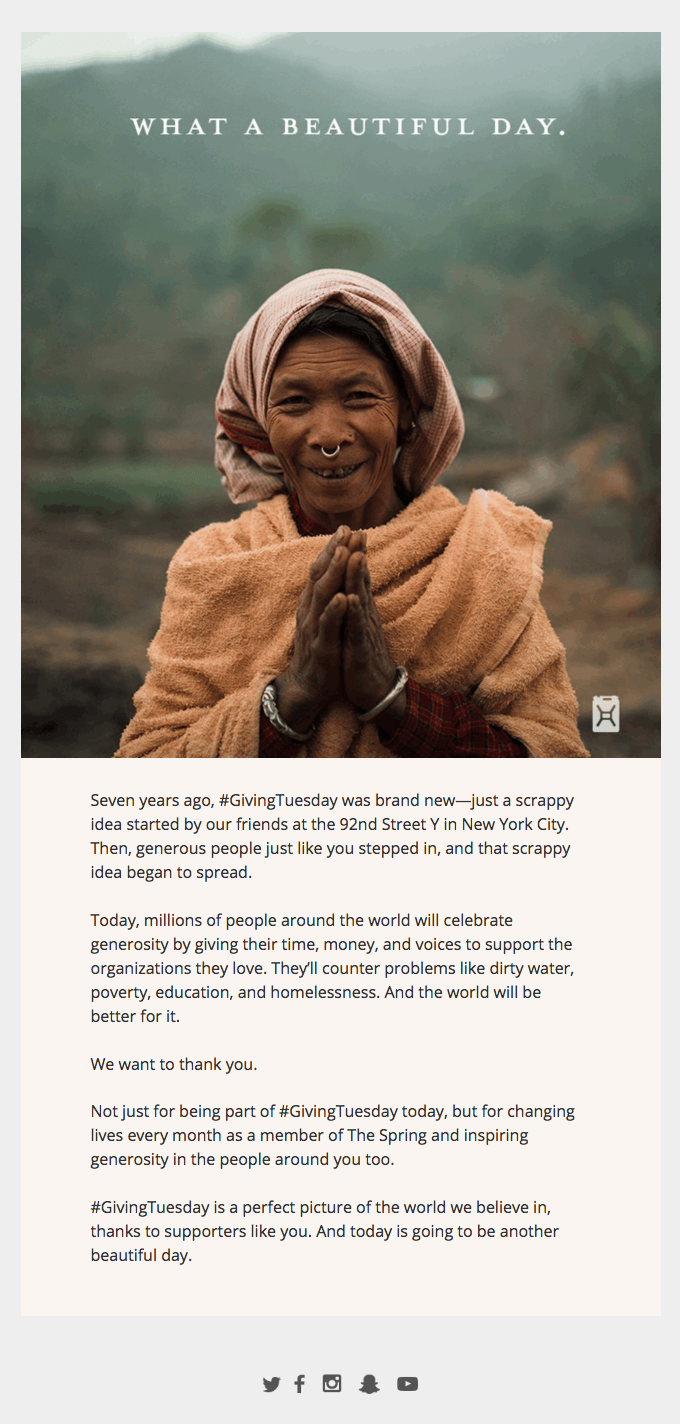 Charity Water thanking their subscribers; source: Really Good Emails
Charity Water thanking their subscribers; source: Really Good Emails
Takeaways:
- Remind subscribers about your journey. Subscribers want to know about the impact they’re making on your organization. Confess how the organization is dependent on subscribers.
- Show people the impact of their aid. Tell subscribers how their donations are driving change. Subscribers will be happy to donate to tackle challenges like dirty water, poverty, education.
- Make donors feel special. Give reasons for appreciating subscribers. Donors will feel valued and are likely to donate again.
What they could have improved:
- Integrate a social sharing button. Subscribers share interesting content with their friends or family.
- Boost credibility. The email could have mentioned the donations amounts raised over a given period: for example, “We collected $100,000 last month, invested $20,000 in educating young girls and $80,000 to feed orphans.”
Event invitation
Here’s how Alzheimer Scotland invited subscribers to their annual Winter Lecture:
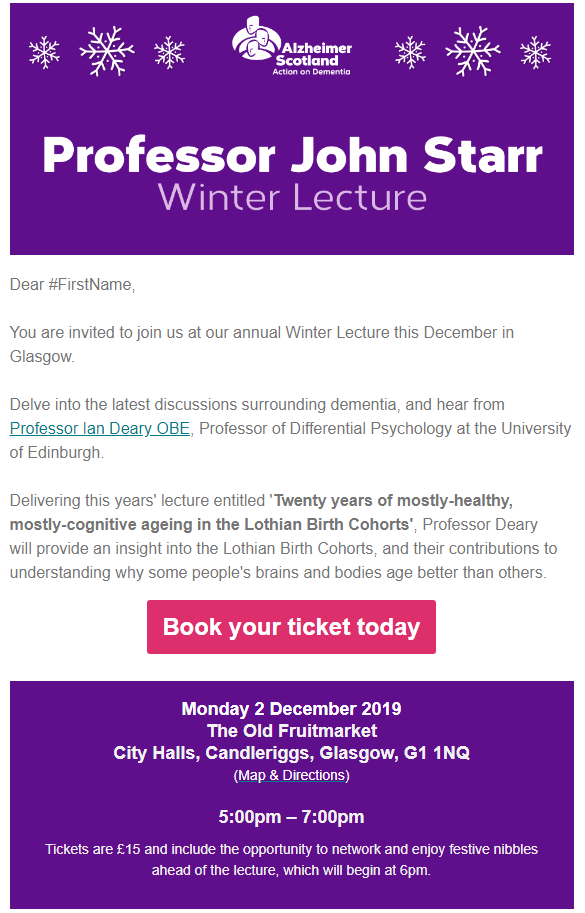 Event invitation email from Alzheimer Scotland
Event invitation email from Alzheimer Scotland
Takeaways:
- Be transparent. Highlight key details regarding your upcoming event. Clarify if tickets are free or not.
- Highlight the benefits of attending the event. Subscribers need reasons to attend your event. People are interested in the value they get from attending an event.
- Use the fear of missing out. FOMO triggers subscribers to take action. Subscribers might grab tickets fast to avoid missing out on the talk.
- Give directions. Never assume subscribers know the directions to your venue. The above email has a link to a map and directions. Anyone unfamiliar with the location can use your map.
- Create a compelling call to action. Position your CTA where subscribers can see it. You can use colors to make it stand out.
What they could have improved:
- Make subscribers feel valued. They could have appreciated the thoughts of subscribers by using words like, “Reach out to us if you have any questions.”
Volunteer email
Below you can see an example of a volunteer email from Help for Heroes:
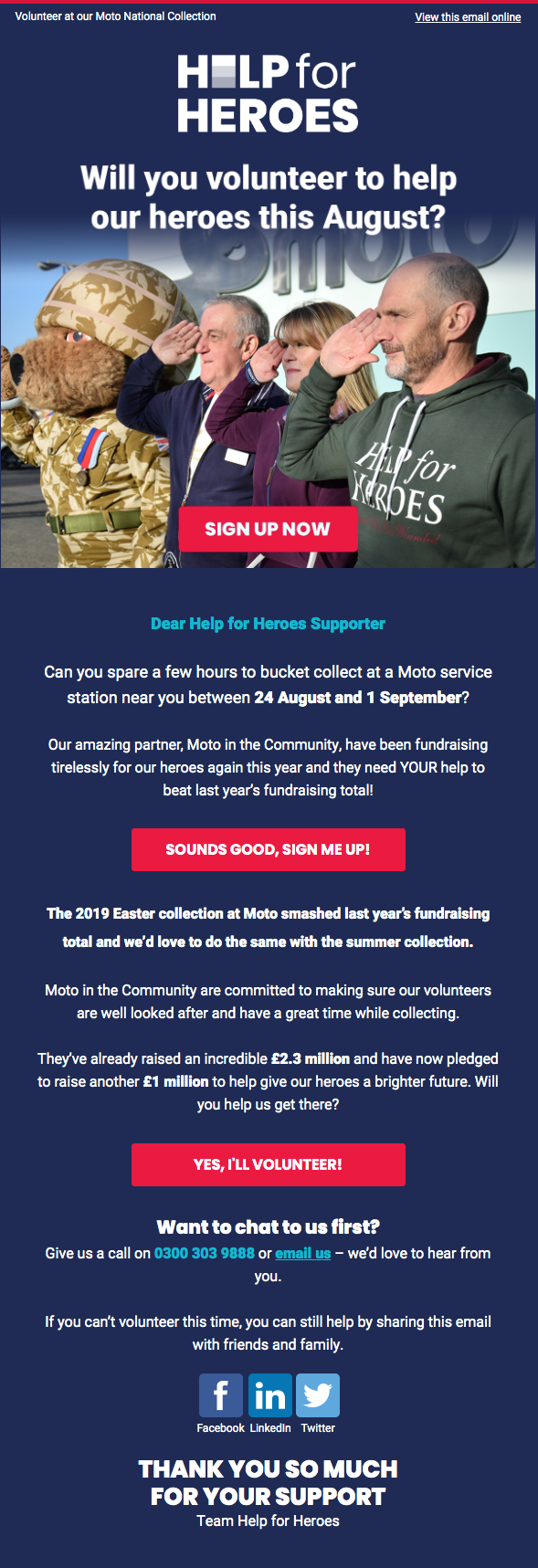 Volunteer email by Help for Heroes; source: Really Good Emails
Volunteer email by Help for Heroes; source: Really Good Emails
Takeaways:
- Include social sharing buttons. Loyal subscribers never mind sharing your content on Facebook, LinkedIn, or other social media channels.
- Mention the date. Subscribers should confirm whether they will be available on the date for your event.
- Provide an alternative channel of communication. For example, some people prefer communicating over the phone than via email. So be prepared to get calls from people who need clarification.
- Be courteous. Professionalism helps portray a good picture of your organization. Being courteous can motivate people to volunteer.
- Make subscribers feel special. Value the thoughts of your subscribers. Some people will relay their suggestions or opinions which builds trust and helps you improve.
- Monitor the performance of your calls to action. You can include at most three CTAs and determine the one subscribers click the most with a click map. It will allow you to optimize future emails for more conversions.
- Be credible. Give subscribers updates on previous events to show the progress you’re making.
What they could have improved:
- Using personalization. They could have identified their subscribers by names.
Content email
Here’s an example of an email with useful content from Red Cross:
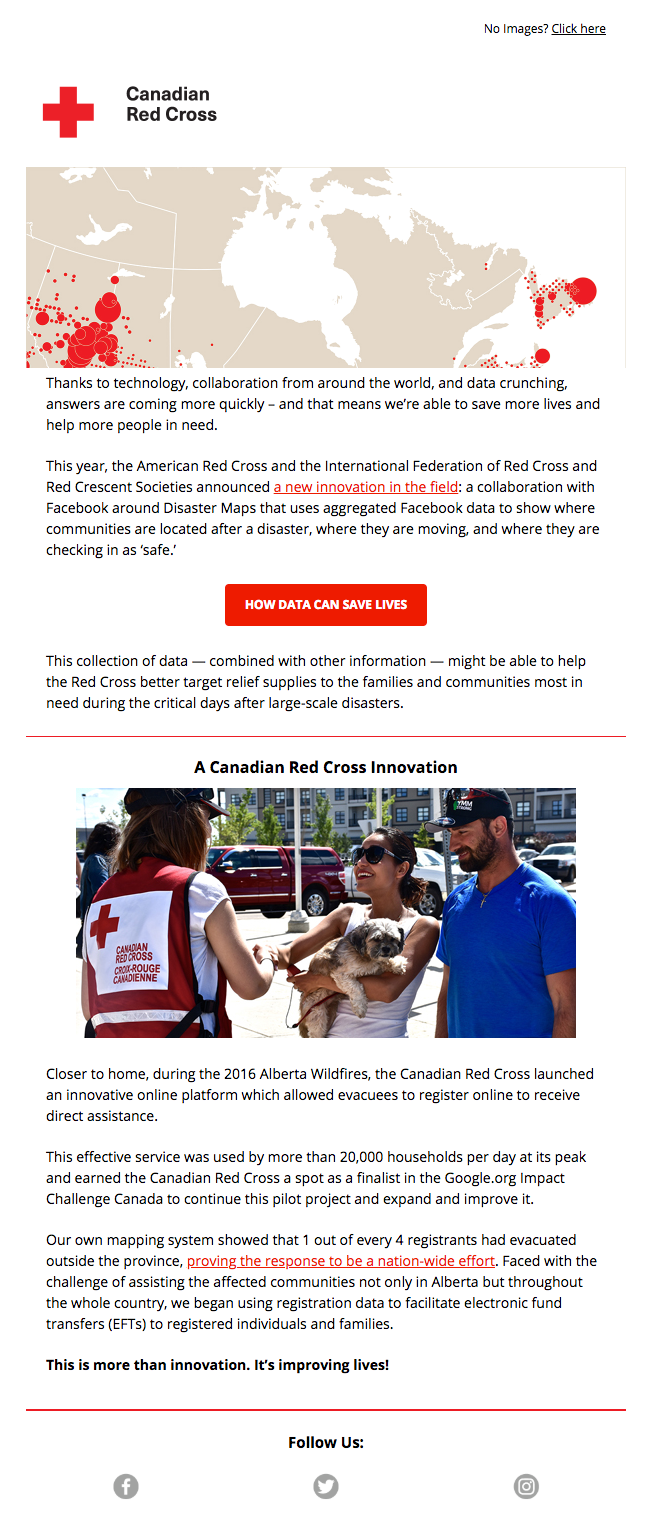 Red Cross sending useful content to their subscribers; source: Really Good Emails
Red Cross sending useful content to their subscribers; source: Really Good Emails
Takeaways:
- Use storytelling. Narrate a story related to the content in your call to action. Subscribers are likely to click the link connected to your story.
- Show the impact of your actions. Show how your organization is driving change. Subscribers want to associate themselves with nonprofits that are making progress.
- Use catchy pictures. Appealing images related to the content in your email are great for building trust.
- Great spacing. Combine it with short sentences to boost readability.
What they could have improved:
- Including social sharing button.
Nonprofit email templates
You can create several nonprofit emails depending on whether you want to ask for donations, thank subscribers, or share awesome content.
We’ve created some templates to help you kickstart your email marketing campaigns.
Thank-you email for nonprofits
Subject line: Your Generosity Means a Lot to Us!
Hi {{name}},
Thank you for being part of our mission since {{date}}. Your contribution has helped us drive change through {{impact}}.
We managed to raise {{amount}} last month.
Here’s how we used the funds:
{{Amount 1}}.
{{Amount 2}}.
{{Amount 3}}.
Feel free to reach out to {{email}} if you have any questions.
Thank you so much for making the world a better place, {{name}}!
Regards,
{{Sender’s name}}
Event invitation email for nonprofits
Subject Line: You Need to See This!
Hi {{name}},
We’ve been super-busy organizing {{event name}} that will be held on {{date}}.
It is aimed at:
{{intention 1}},
{{intention 2}},
{{intention 3}},
So far, {{number}} people have registered, but we’re trying to gather more. We decided to inquire if you can make it on the scheduled date.
Click here {{link}}, to book your space today.
Reach out to {{email}} if you have any questions regarding the event.
Hope to see you there!
Looking forward,
{{Sender’s name}}
Content offers for nonprofits
Subject line: Grab This Freebie Now
Hi {{name}},
Thank you for downloading {{Content name}} last week. We also thought you might be interested in watching a webinar we hosted last week regarding {{topic}}.
Here are the benefits you will get from watching it:
- {{Benefit 1}}
- {{Benefit 2}}
- {{Benefit 3}}
Click here {{link}} to grab the replay. Enjoy!
PS: The content will expire after 24 hours.
Regards,
{{Sender’s name}}
Ready to do nonprofit email marketing?
Nonprofit marketing can be challenging. Chances are, you will be doing several tasks while striving to raise donations or thank your donors.
However, you can reduce your workload by embracing nonprofit email marketing to complement other marketing methods. Yes, launching your campaigns may seem like a daydream. But you will master how to grow your donor base, use an excellent email marketing tool like SendPulse, and automate marketing like a pro.
With time, you’ll be a wizard at creating personalized content donors resonate with. Unlike before, the donation amounts will skyrocket, and subscribers will happily volunteer.